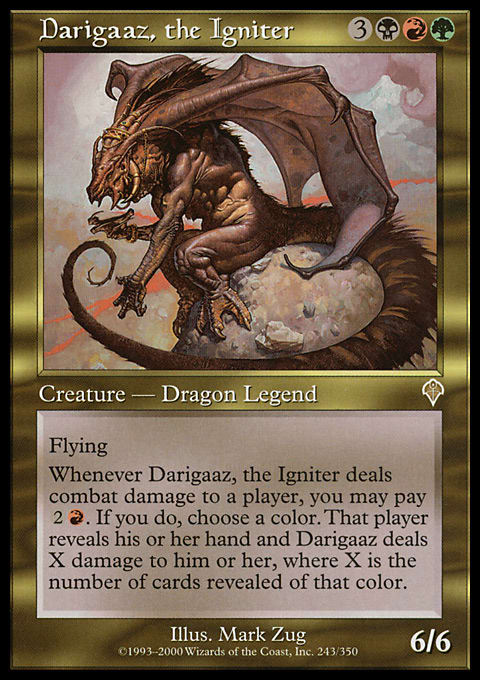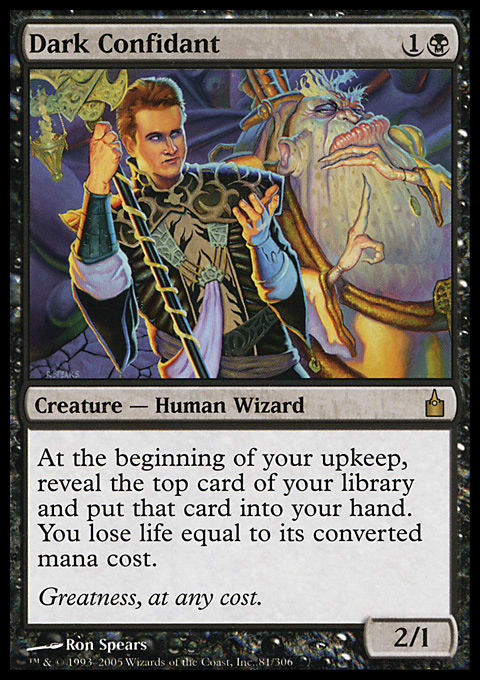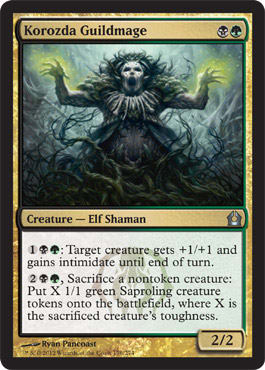I like to think of myself as a Spike. In Constructed and Limited, I play to improve my skills and, of course, to win. I take on a very serious demeanor when working with my Cube. While I love the draft itself, I want to gather information to improve the experience for future sessions. Commander, though, is where I go crazy. Commander is where I am able to expand on all the nifty interactions that may not make the cut in a more competitive environment. I am able to flex my deck-building muscles and create an experience, not just a stack of cards. And I do it across the board—with ten decks and counting. Even though I love piloting all my creations, one stands above the rest.
Jarad, Golgari Lich Lord is the commander of my favorite stack of ninety-nine cards. I have had this deck together, in some way, shape, or form, since 2009. What started as a hastily-thrown-together Darigaaz, the Igniter deck for the first Community Cup begat a Glissa, the Traitor deck. And Glissa begat Skullbriar, the Walking Grave, who begat Jarad. This history has influenced the current construction of the deck almost as much as my own personal preferences.
As Darigaaz, the deck was an underpowered good-stuff build. My goal was just to have a deck to play on my trip to Wizards of the Coast to battle for the community. I kept Darigaaz together for about a year until Glissa, the Traitor was revealed and my heart migrated from Jund to the sewers of Ravnica. Under the guidance of Glissa, the deck was forcibly evolved into something that resembled a typical Glissa list. I loved the deck, especially when I would be able to pull creatures and artifacts out of my graveyard.
Then, the original Commander product hit the shelves, and Skullbriar caught my eye. There it was, shambling out of a graveyard and making use of counters. I shaved the main artifact theme from my list and left it as an attempt at an aggressive Voltron build trying to force Skullbriar through. Glissa remained for an Equipment subtheme and because I couldn’t part with the Executioner's Capsule combo. It was at this time when Dark Confidant found its way into the deck.
And that is when everything changed.
I had opened a Bob during the original Ravnica block, and it sat in my binder for years. I didn’t play Constructed as much back in the day, so there it sat, eating up space and not drawing anyone any cards. At some point during the saga of this deck, I read Sheldon Menery’s article on his Nath of the Gilt-Leaf deck, and I realized I wanted to optimize Dark Confidant. From that day forward, nothing in the deck would cost more than 5 mana. Why 5? The number stuck in my head since Sheldon’s article, but it ended up being correct. Doing so has helped keep the average converted mana cost of the deck down while also forcing me to look for different solutions to the format. Taking away cards such as Woodfall Primus and Decree of Pain has helped me find some cards I have grown to love.
Skullbriar gave way to Jarad, Golgari Lich Lord once Duel Decks: Izzet vs. Golgari became public knowledge. Jarad hit home for me—it was a card that wanted me to dump cards into my graveyard, and it cost less than 5 mana. It was a riff on one of my favorite cards in Lhurgoyf (my first Ice Age starter deck had Lhurgoyf, Stormbind, and Necropotence, and the skull was my third-most-loved card in that pack), and it awakened my cold Golgari heart.
With Jarad at the helm, the deck took a turn toward dredge. Coming off Innistrad block, I had multiple cheap tools at my fingertips, and I decided I was going to put as many of them to use as possible. The deck became a powerhouse, and it remains my deck that wins more than it loses. It is a relatively redundant deck and leans heavily on using the graveyard as a secondary hand. In order to put myself under pressure to finish games, I’ve included quite a few elements that force me to act. In addition to Dark Confidant, the deck runs Dark Tutelage for a harder-to-remove source of card-draw. Splinterfright and Sewer Nemesis fill the ’yard at a rapid pace, encouraging me to try to win before I deck myself.
Here is my current build:
Jarad, Golgari Lich Lord ? Commander | Alex Ullman
- Commander (0)
- Creatures (40)
- 1 Big Game Hunter
- 1 Blood Artist
- 1 Bloodghast
- 1 Bloodgift Demon
- 1 Bone Shredder
- 1 Champion of Lambholt
- 1 Corpse Connoisseur
- 1 Creakwood Liege
- 1 Dark Confidant
- 1 Disciple of Bolas
- 1 Disciple of Griselbrand
- 1 Eternal Witness
- 1 Falkenrath Noble
- 1 Genesis
- 1 Hermit Druid
- 1 Kessig Cagebreakers
- 1 Korozda Guildmage
- 1 Lotus Cobra
- 1 Lumberknot
- 1 Masked Admirers
- 1 Mold Shambler
- 1 Nessian Demolok
- 1 Nighthowler
- 1 Nyx Weaver
- 1 Oracle of Mul Daya
- 1 Pharika's Mender
- 1 Phyrexian Plaguelord
- 1 Reassembling Skeleton
- 1 Reclamation Sage
- 1 Satyr Wayfinder
- 1 Scavenging Ooze
- 1 Sewer Nemesis
- 1 Shadowborn Demon
- 1 Splinterfright
- 1 Vengeful Pharaoh
- 1 Yavimaya Elder
- 1 Solemn Simulacrum
- 1 Pharika, God of Affliction
- 1 Savra, Queen of the Golgari
- 1 Varolz, the Scar-Striped
- Planeswalkers (1)
- 1 Garruk Relentless
- Spells (22)
- 1 Grim Harvest
- 1 Damnation
- 1 Demonic Tutor
- 1 Gaze of Granite
- 1 Jarad's Orders
- 1 Life from the Loam
- 1 Living Death
- 1 Awakening Zone
- 1 Dark Tutelage
- 1 Deathreap Ritual
- 1 Grave Pact
- 1 Grim Feast
- 1 Oversold Cemetery
- 1 Phyrexian Reclamation
- 1 Survival of the Fittest
- 1 Sylvan Library
- 1 Bonehoard
- 1 Mimic Vat
- 1 Nim Deathmantle
- 1 Skullclamp
- 1 Sol Ring
- 1 Whip of Erebos
- Lands (36)
- 6 Swamp
- 9 Forest
- 1 Barren Moor
- 1 Bojuka Bog
- 1 Command Tower
- 1 Evolving Wilds
- 1 Gilt-Leaf Palace
- 1 Golgari Guildgate
- 1 Golgari Rot Farm
- 1 Grim Backwoods
- 1 Jund Panorama
- 1 Oran-Rief, the Vastwood
- 1 Overgrown Tomb
- 1 Polluted Mire
- 1 Rogue's Passage
- 1 Slippery Karst
- 1 Tainted Wood
- 1 Temple of the False God
- 1 Terramorphic Expanse
- 1 Tranquil Thicket
- 1 Treetop Village
- 1 Verdant Catacombs
- 1 Volrath's Stronghold
Jarad has benefitted from the recent push toward making black and green the graveyard-matters Draft archetype. Theros block provided some key elements, including Nyx Weaver and Nighthowler. It was drafting the graveyard deck in triple-Theros that helped me realize how many important enchantments there are in this deck, and that led me to find home for Pharika's Mender. The addition of the Gorgon has been nothing but great, as it provides another Eternal Witness variant.
This deck wants to lock up the board. Between tokens and creatures that take out permanents once they hit the battlefield, it is very easy to dictate what sticks around. Eventually, Grave Pact with Blood Artist hits the table alongside a sacrifice outlet, and then boards start to shrink.
Jarad provides a chance for me to showcase some personal favorites that otherwise are passed over in favor of more expensive options.
Korozda Guildmage is a utility superstar. The first ability helps my death-fueled minions to connect for large swaths of damage. Later on, it turns those same large monsters into a token army that can then fuel various death engines.
I fell in love with Nyx Weaver the moment it was spoiled. The ability to self-mill and gain a pseudo-tutor is exactly what this deck wants. Alongside Splinterfright, it isn’t hard to turn cards like Phyrexian Reclamation and Volrath's Stronghold into Worldly Tutor.
Speaking of tutors, this deck runs my favorite one in Corpse Connoisseur. This deck has no problem retrieving creatures from the discard pile, so the Connoisseur’s drawback vanishes. Being able to come back for seconds is a huge bonus, and then it can be sacrificed on the Golgari altar. This showcases the more Rube Goldbergian elements of my deck design—using multiple cards where one could suffice. However, each piece interlocks so well that I have a hard time cutting any one cog.
Finally, Grim Feast is a great way to recoup life in this build. Between Dark Confidant and Dark Tutelage, Jarad operates at a sometimes precariously low life total. Grim Feast works alongside the board-control elements to keep me healthy. Its 1-life drawback is also a reminder that I need to act—and not just sit around waiting for my opponents to do stuff.
With the official Khans of Tarkir release just around the corner, there are a few cards that have caught my eye as potential inclusions:
- Bloodsoaked Champion would be a welcome way to boost the output of several elements. Requiring me to attack also plays into Jarad’s focus on making me act.
- Death Frenzy, while an underpowered sweeper, can throw a wrench into token strategies and gain the deck a decent amount of life. And this deck loves all the incidental life-gain it can find.
- Grim Haruspex is probably not at its best in this deck, as it does lean a bit heavily on the death of tokens. That being said, drawing cards is always good.
- Kheru Bloodsucker helps drain my opponents while acting as another, slow, sacrifice outlet.
- Swarm of Bloodflies would be another Lumberknot. Without a focus on counters, this one probably falls by the wayside.
Jarad’s is my favorite deck. Not only does it align with how I enjoy playing Magic, but it also allows me to play some of my favorite cards. My self-imposed restrictions force me to eschew more powerful options in favor of synergy while not taking away from the overall effectiveness of the deck. I am always searching for feedback on this one, as I love having it be as optimized as possible while still adhering to its tenets, so sound off below. Let me know what your favorite deck is and why, and share whether you have any self-imposed limits on any of your Commanders.





























